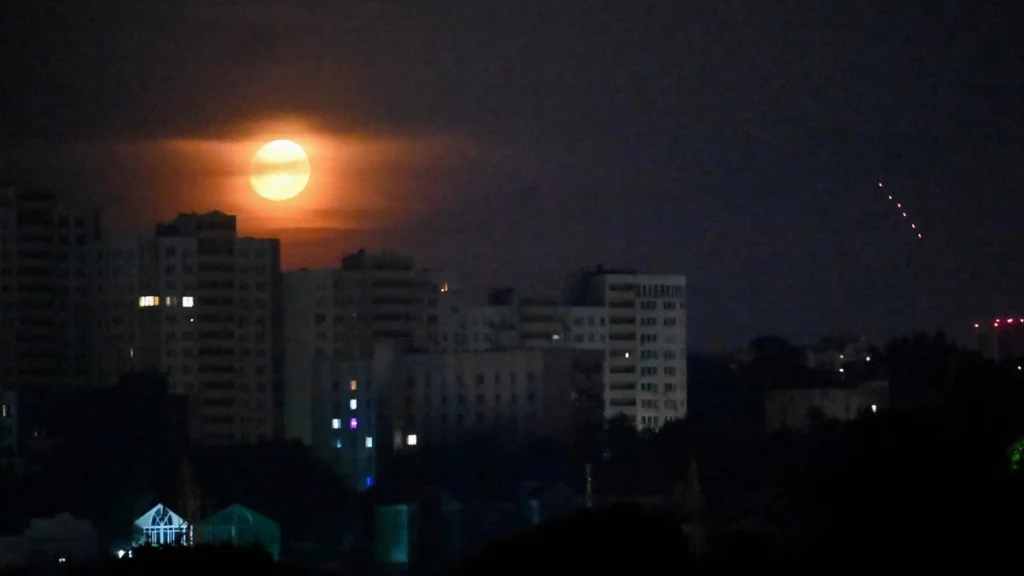Russia fires a record 728 drones and 13 missiles at Ukraine, Ukrainian air force says

Russia launched a record 728 drones and 13 missiles at Ukraine overnight, marking a significant escalation in aerial assaults. The Ukrainian Air Force confirmed the attack, calling it a major threat to Ukraine’s defenses. Despite Ukraine’s efforts to intercept the missiles and drones, many still managed to reach their targets, causing significant damage.
Scale of the Attack
The Russian assault involved 728 Shahed drones and 13 missiles. Shahed drones are small and fly at low altitudes, making them hard to detect. They were launched in waves to overwhelm Ukraine’s defenses. The missiles, aimed at strategic locations, targeted military bases, power plants, and logistics hubs.
These attacks are part of Russia’s broader strategy to cripple Ukraine’s infrastructure. Despite Ukraine’s strong air defense systems, the volume of drones and missiles made it difficult to intercept them all. The Ukrainian Air Force managed to down many, but some missiles reached their targets, leaving significant destruction in their wake.
Ukrainian Air Defense Struggles
Ukraine’s air defense systems, backed by Western support, have been under heavy strain. The country’s military has successfully intercepted numerous incoming threats, but the constant barrage of drones and missiles is testing their limits. Ukraine’s air defense systems, including Patriot missile batteries, remain effective but face challenges against the high volume of attacks.
The Russian strategy includes using decoy drones to confuse radar systems, making it harder for Ukrainian forces to identify real threats. This tactic forces Ukraine’s defense systems to divide their attention, making interception more difficult.
Damage to Infrastructure
Russia’s missile and drone strikes caused extensive damage to Ukraine’s infrastructure. Many key power plants, water facilities, and transportation hubs were hit, leaving parts of Ukraine without electricity and basic services. The strikes disrupted everyday life and worsened the humanitarian situation.
The attacks also targeted civilian infrastructure, leaving many without access to necessities. Hospitals and schools have been damaged, and the population faces shortages of food, water, and medical supplies. These strikes highlight Russia’s strategy to target both military and civilian resources to break Ukraine’s resolve.
The Role of Drones in Russia’s Strategy
Drones have become a central element of Russia’s offensive. They are cost-effective, allowing Russia to carry out frequent, low-cost attacks. These drones are small, which makes them harder to spot and intercept. By launching hundreds of drones at once, Russia aims to overwhelm Ukraine’s defense systems and inflict maximum damage.
In addition to their tactical advantages, drones also serve as a psychological weapon. The constant threat of drone strikes creates an atmosphere of fear and uncertainty. The Ukrainian population is forced to live under the constant threat of aerial attacks, leading to growing anxiety and distress.
The International Response
The international community has condemned Russia’s use of drones and missiles against Ukraine. The United States, European Union, and other allies have reaffirmed their support for Ukraine, providing additional military aid and air defense systems. However, experts warn that Ukraine still faces significant challenges in defending against such large-scale attacks.
The U.S. has pledged more advanced air defense systems, such as additional Patriot missile batteries. But these systems are not yet fully operational, and it will take time for them to be deployed effectively across Ukraine. Until then, Ukraine must continue to rely on its existing systems, which are being stretched to their limits.
Global Concerns Over Drone Warfare
The increased use of drones in warfare is a growing concern worldwide. Drones allow countries to carry out precision strikes without putting their own troops at risk. However, they also raise serious ethical and legal questions, particularly when used to target civilians or critical infrastructure.
Russia’s heavy reliance on drones in Ukraine could set a dangerous precedent for future conflicts. Many nations, including the United States, are now reviewing their own drone capabilities in light of Russia’s actions. The ability of smaller nations or non-state actors to deploy drones for military purposes has the potential to change the dynamics of global security.
The Road Ahead for Ukraine
Ukraine’s military is adapting to the growing threat of drone and missile attacks, but it requires more support to effectively counter these threats. The volume of Russian drone strikes and missile assaults is expected to continue, and Ukraine will need to strengthen its air defense systems further.
As Russia continues to launch attacks, Ukraine’s resolve remains strong. However, the country faces an uphill battle in defending its airspace and infrastructure. The international community must continue to provide aid and support, including advanced technology to bolster Ukraine’s defense systems.
Conclusion
Russia’s record-breaking drone and missile attacks on Ukraine mark a dangerous escalation in the conflict. The sheer scale of the attacks, combined with the challenges faced by Ukraine’s air defense systems, presents a major threat to the country. Despite receiving Western support, Ukraine is struggling to defend itself against the continuous barrage of Russian strikes.
As the conflict continues, the international community must continue to support Ukraine with the necessary resources to defend itself. Ukraine’s ability to withstand these attacks will determine its future, and the global community’s response will play a critical role in shaping the outcome of this ongoing conflict.
Moving Forward
The future of Ukraine hinges on its ability to counter these aggressive attacks and secure the necessary support from international allies. While the Ukrainian military has shown resilience, the ongoing pressure from Russia’s aerial assaults underscores the need for stronger defense systems and continued international cooperation. The fight for Ukraine’s sovereignty is far from over, and the world’s support will be crucial in determining the outcome.






